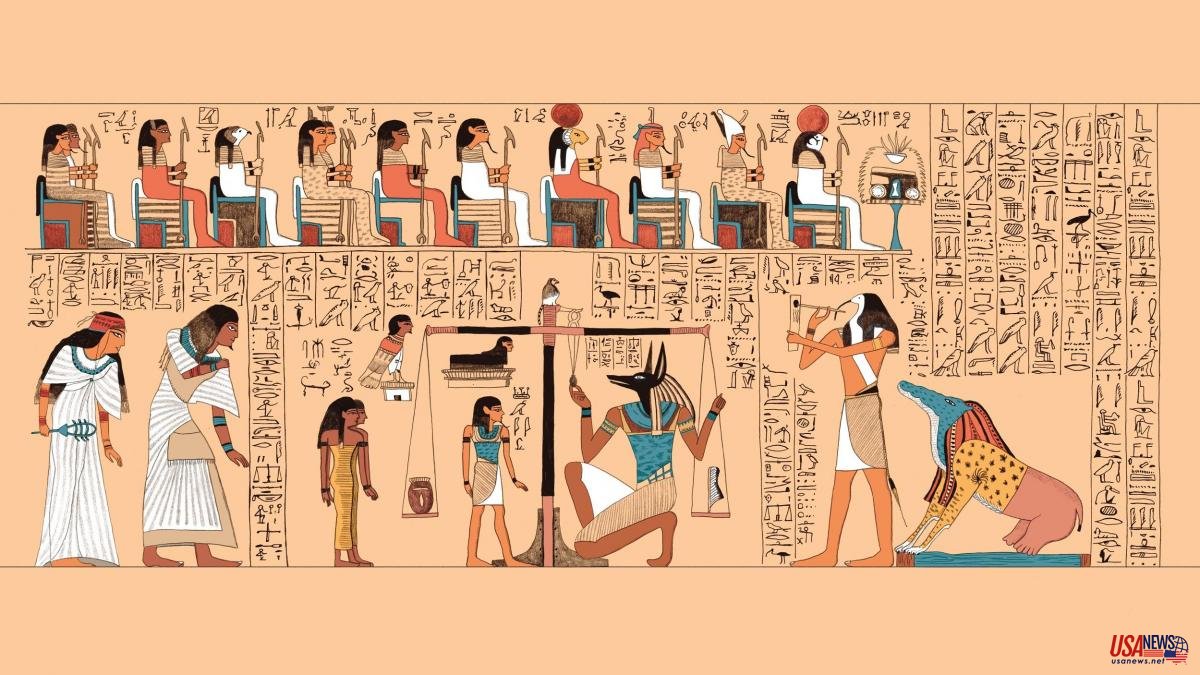On November 4, 1922, one of the most exciting archaeological discoveries of the last century was revealed to the world: the intact tomb of Tutankhamun. A finding that came with a curse included, about which not a little has been written. The fascination for this pharaoh and for all of Ancient Egypt in general has gained strength during this year that we have left behind, coinciding with the centenary of the discovery of this spectacular tomb, with very interesting editorial proposals for children and adolescents, capable of transporting us to the splendid years of this civilization that never ceases to seduce us. Tales that tell is dedicated in this article to review.
One of the most interesting proposals is the one that has come to us from the publisher Mosquito Books, who has invited the director of the magazine Petit Sapiens, Àlex Novials, to share all his knowledge about Tutankhamun and Ancient Egypt in Tutankhamun, the child pharaoh and the discovery of his tomb, a book of knowledge illustrated by Eva Palomar that starts as a memoir putting into context who Howard Carter is and how he found the whereabouts of the tomb. Entertaining, concrete and very useful information that using Pharaoh Tutankhamun as a framework, brings us closer (from 10-11 years old) to the Egyptian society of thousands of years ago, to its way of functioning, its beliefs, its system of government and its expansion along the Nile.
One of the most interesting aspects that this large-format book delves into is the making of papyri and the meaning of hieroglyphics, as well as the concepts of the afterlife and eternity. A list of the most important gods with their recreation has just placed us in this ancient culture that still holds many surprises for us today (also in Catalan).
The Barcelona writer and historian Maria Carme Roca has also paid her particular tribute to the archaeologist Howard Carter and the discovery of Tutankhamun's tomb through a work that mixes history and fiction to recreate that moment. The novel, Tutankhamun, the discovery of the tomb (Anaya/Barcanova), runs through two periods: the first, from November 3, 1922 when Howard Carter, installed in the Valley of the Kings for weeks, received notification that the steps that supposedly lead to the tomb of the little pharaoh have been found. The other historical moment goes back to the 14th century BC, to Ancient Egypt, to the years preceding the enthronement of little Tutankhamun as the new pharaoh.
In both stories, the writer makes use of her great baggage to put together an attractive and mysterious plot with which she leads us through the recesses of the past and makes us imagine not only how such a magnificent discovery could have been and the misgivings it aroused, but also to recreate his protagonist in what could have been part of his life. Tutankhamun's mother already predicted it: "You will be immortal and your name will be remembered forever." An omen that sustains the entire work and gives it wings (from 12-13 years old).
Another historian and writer of youth literature fascinated by Tutankhamen and Ancient Egypt, the Valencian Enric Lluch, contributes his grain of sand to the myth with Tut-ank-Amón, the young pharaoh (Bruño) where he humorously reinterprets his short reign. He baptizes his characters with names like Tut, Guap-ay-reguap-a, Col y Sal or Ank, and makes his particular interpretation of historical facts about which there are still certain doubts, such as the reason for the erroneous measurements of the sarcophagus, the funeral mask or the causes of death of the pharaoh. A pleasant approach to Ancient Egypt for readers aged 10 and over.
The British Egyptologist Chris Naunton, who a couple of years ago provided archeology lovers with an extraordinary Egyptologists' Notebooks (Blume), puts himself in the shoes of Tutankhamen to explain to young readers (from 7 -8 years) everything there is to know about his reign, his family, the theories of his death and even his botched burial. Pharaoh Tutankhamen explains everything (VVkids/Baula), illustrated by Guilherme Karsten, is an excellent book of knowledge that in a concise, intelligible and fun way explains the most essential aspects of the pharaonic figure, including more spiritual aspects such as funeral rites or the symbology of the elements found in the tomb of the young pharaoh.
Another of the very interesting books that have come down to us, has been done by the British Museum: Mummies uncovered (Anaya / Barcanova), a compendium of information on all the steps that were followed to mummify the dead with some figures that give us leave you speechless For example, the more than 375 meters of cloth used to wrap some mummies or the lucrative trade in fake animal mummies that were sold as votive offerings. There is no detail that is not included in this large-format book, illustrated by Tom Froese, where we also find some of the most famous mummies in history, starting with Tutankhamun's (from 7-8 years).
Speaking of mummies, one of the titles that is yet to come is Dummie, the mummy and the golden beetle (Duomo) by Tosca Menten (in bookstores on February 13), a mix of comedy, adventure and mystery about a boy , the son of Pharaoh Akenut and Queen Enisis, who dies at a very young age and comes back to life as a mummy thousands of years later, where he is adopted by Gus and his father. Stinky, dirty and deliciously innocent and funny, the mummy Dummie (as he is renamed) has to deal with modern life, something that seduces and horrifies him in equal measure. His favorite invention is the vacuum cleaner, and his highlight is the day she set foot in Gus's school to be his classmate. “We see what we think we see”, and at school everyone sees a boy who hides with bandages the scars of a supposed fire in his house in Egypt. Everything seems to be going well until the Mukatagara gold scarab disappears, a powerful amulet that the pharaoh bequeathed to his son when he died and that after giving him life, now seems to cause his death (from 9 years).
Thanks to die-cutting, The Secrets of the Egyptian Mummies (Bruño) by Lorraine Jean Hopping allow the young investigator (9 years and older) to uncover, layer by layer, tombstone by tombstone, piece by piece, the secrets hidden in the mummies of the egyptian royalty. Pages that, like a sarcophagus, go into the recesses of these ancestors until they are literally left in the bones. Everything is revealed to us on a symbolic and physical level: souls, gods, amulets, writings for the afterlife... Tutankhamen has, of course, a prominent place in these splendid hardback pages.
Egypt, its mythology, its architectural wonders and its history are the basis of the novel Les ales d'Isis (Barcanova) with which Marta Colomé Romera won the Guillem Cifre de Colonya award a couple of years ago. It was one of the first titles to reach our newsroom of this new batch of books about pharaohs, along with the Ancient Egyptian Treasure Chest (Edebé) with which Matthew Morgan and Mutti (illustrations) invited kids aged 8 and up to ride sphinxes, pyramids and pharaonic tombs.
Colomé traveled to Egypt hand in hand with the “troballibres”, three librarians and friends on a mission to search for a very important papyrus: a compendium of enchantments as old as the origin of the world, more than the Book of the Dead or the Book of thoth. Ada, Robin and Sun immerse themselves in the narrow streets of Cairo and among the shops of the Grand Bazaar Khan el-Khalili they discover that what they are looking for is the Book of Life, also known as The Wings of Isis, a text that can only be read by the chosen person. A fictional and intriguing story that drinks from historical sources to anchor us more in the plot.
Many of the great discoveries that have revolutionized our lives have been by chance. A few days ago we were discussing the book Blessed errors (Mosquito Books), where Soledad Romero and Montse Galbany go through history in search of errors that gave rise to such incredible discoveries as penicillin, coffee, champagne, the microwave or the eraser . Sarah Albee's proposal in Archaeologists by Accident (Siruela) focuses on fortuitous archaeological discoveries, which gave rise to spectacular discoveries such as the Rossetta stone by a private in Napoleon's army, when he was no more than a general .
Other examples: the peasants who wanted to dig a well in a year of extreme drought came across the enormous discovery of the Siamese warriors in China, or the young Bedouin nomad who, looking for a lost goat, found what was later called the Dead Sea Papyri, the oldest known religious writings.
Many of the finds described here also have to do with Ancient Egypt. In addition to the Rosetta stone, Sara Albee, with a simple and attractive pen, tells how the so-called Crocodile Archives or the entrance to the main chamber of one of the colossal pyramids of Giza were found. A book that covers some of the main sites in the world where many would have liked to become archaeologists, even if it was accidentally.
And in case any of the readers do not know very well what an archaeologist is, the publishing house La esfera de libros has published The Young Archaeologist's Manual, a fun compendium of concepts, reflections and activities that result in a work halfway between the activity book and the knowledge book. The proposal, for curious people from the age of 7, is illustrated by the Italian Stefano Tognetti and signed by a group of Italian archaeologists belonging to a group dedicated to disseminating cultural heritage among children and which can also be found at www.archeokids. Item
Continuing in the field of archaeology, we echo once again the collection that Clar Books has launched to explain some curious professions such as Màrius Serra's enigmist. In this Why am I an Egyptologist?, by Jordi Ortiz, the author delves into the life of the Egyptologist Josep Cervelló to discover a restless child, full of questions and always moved by great curiosity. We found him on the beach, with his inflatable mattress, rowing with his hands and imagining himself embarking on a great Greek expedition. He also visiting Roman monuments hand in hand with his mother, a great feeder of his son's desire for knowledge. An interesting and illustrative story about how vocations come to be forged (for readers aged 10 and over) illustrated by Àfrica Fanlo and with QR codes that make this reading proposal a more interactive practice (also in Catalan).
Another great book that has come to our writing talks about one of the great pharaohs of all Ancient Egypt: Hatshepsut. Written in the first person, as if the sovereign herself were speaking to us from beyond the grave, The Great Pharaoh (Petit Sàpiens) tells the story of her reign and how she was proclaimed pharaoh at a time when this position was only held by men. She was an exception, and there weren't many more, really. So this story is therefore doubly interesting. The author is not limited only to the reign of Hatshepsut: her text is full of ancient beliefs, myths and practices (from 7-8 years).
To finish this extensive compilation, comment on three books so that the little ones also begin to delve into this fascinating world of pharaohs, pyramids and mummies. A civilization with another way of seeing and understanding the world that surrounds us and from which we learn new things every day. The first is the one signed by the authors Sophie Dussaussois and Vanessa Robidou, The Book of Pharaohs (from 5 years old), in a collection edited by SM and Cruïlla (Catalan version) on historical themes, with pop-ups, flaps and other resources that make these proposals more interactive. The lapels are also the resource used by authors Joshua George and Ed Myer to animate The Ancient Egyptians (Bruño). A hardcover book for the same age group as the previous one that talks not only about pharaohs, but also about the Nile, agriculture, the gods and everyday life.
And finally, a diversion that comes to us from the hand of the illustrator Virginie Vidal: The mysterious pyramid (Anaya / Barcanova) where Florent Lepeytre presents the reader with an adventure that takes place inside the Great Pyramid, where a group of boys discover a secret entrance and decide to enter. This is how the colorful world imagined by Vidal begins, who uses the interior of the pyramid to turn it into a kind of community of neighbors where many things happen and where many references are made to games like Minecraft or characters like Indiana Jones.













